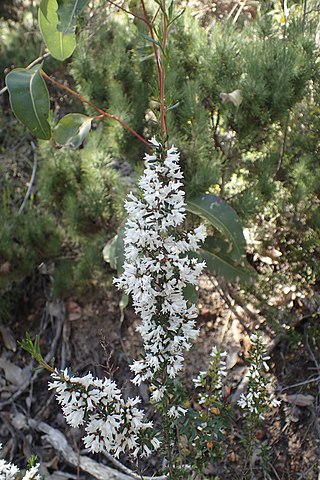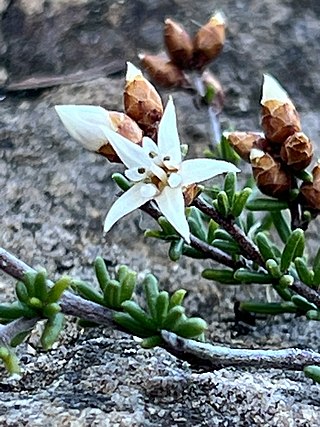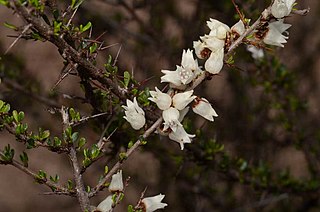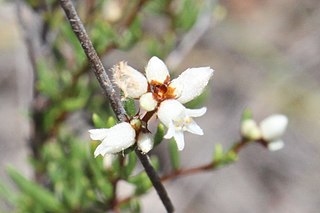
Cryptandra arbutiflora, commonly known as waxy cryptandra, is a species of flowering plant in the family Rhamnaceae and is endemic to the southwest of Western Australia. It is a shrub with spiny branches, elliptic to linear leaves and tube-shaped white flowers.

Cryptandra amara, commonly known as bitter cryptandra or pretty pearlflower, is a species of flowering plant in the family Rhamnaceae and is endemic to eastern Australia. It is a densely-branched shrub with clustered, more or less linear to egg-shaped or elliptic leaves, and tube-shaped white flowers arranged on the ends of branchlets.

Cryptandra aridicola is a flowering plant in the family Rhamnaceae and is endemic to inland areas of Western Australia. It is a small, spreading shrub with white or pink flowers.
Spyridium minutum is a species of flowering plant in the family Rhamnaceae and is endemic to the south of Western Australia. It is an erect or spreading shrub with broadly egg-shaped or heart-shaped leaves, and groups of two or three hairy, white flowers.

Cryptandra armata is a flowering plant in the family Rhamnaceae and is endemic to Queensland. It is a shrub with spiny branchlets, spatula-shaped to lance-shaped or egg-shaped leaves with the narrower end towards the base, and creamy-white tube-shaped to bell-shaped flowers.
Cryptandra beverleyensis is a species of flowering plant in the family Rhamnaceae and is endemic to the southwest of Western Australia. It is a shrub with narrowly oblong leaves and clusters of white, tube-shaped flowers.
Cryptandra campanulata is a species of flowering plant in the family Rhamnaceae and is endemic to South Australia. It is a shrub with narrowly elliptic to narrowly egg-shaped or linear leaves and clusters of white, bell-shaped flowers.
Cryptandra congesta is a flowering plant in the family Rhamnaceae and is endemic to a restricted area of the south-west of Western Australia. It is a low, spreading shrub with narrowly egg-shaped or narrowly oblong leaves and clusters of white, tube-shaped flowers.
Cryptandra craigiae is a flowering plant in the family Rhamnaceae and is endemic to a restricted area of southern Western Australia. It is a shrub with linear leaves and dense clusters of white or cream-coloured, tube-shaped flowers.

Cryptandra debilis is a species of flowering plant in the family Rhamnaceae and is endemic to north Queensland. It is a small shrub with clustered, linear leaves and densely-hairy, white, tube-shaped flowers.
Cryptandra distigma is a flowering plant in the family Rhamnaceae and is endemic to inland Western Australia. It is a shrub with oblong or narrowly egg-shaped leaves and clusters of white to cream-coloured, tube-shaped flowers.
Cryptandra exserta is a flowering plant in the family Rhamnaceae and is endemic to inland Western Australia. It is a shrub with narrowly oblong leaves and clusters of white, tube-shaped flowers.
Cryptandra glabriflora is a flowering plant in the family Rhamnaceae and is endemic to Kalbarri National Park in Western Australia. It is a low shrub with linear or oblong leaves and clusters of white or pink, tube-shaped flowers.
Stenanthemum bremerense is a species of flowering plant in the family Rhamnaceae and is endemic to the southwest of Western Australia. It is an erect, or low spreading shrub with hairy young stems, broadly egg-shaped leaves and densely hairy heads of tube-shaped flowers, sometimes with whitish floral leaves.
Cryptandra imbricata is a flowering plant in the family Rhamnaceae and is endemic to the southwest of Western Australia. It is a spreading shrub with spiny, interlaced branchlets, narrowly oblong to linear leaves and spike-like clusters of white, tube-shaped flowers.
Cryptandra inconspicua is a flowering plant in the family Rhamnaceae and is endemic to the southwest of Western Australia. It is a small, spreading shrub with spiny, interlaced branchlets, narrowly oblong to linear leaves and spike-like clusters of tiny white, tube-shaped flowers.
Stenanthemum divaricatum is a species of flowering plant in the family Rhamnaceae and is endemic to the southwest of Western Australia. It is a small, often spiny shrub with sparsely hairy young stems, fan-shaped to narrowly egg-shaped leaves and densely, softly-hairy heads of tube-shaped flowers.
Cryptandra intermedia is a flowering plant in the family Rhamnaceae and is endemic to the southwest of Western Australia. It is a small shrub, usually with spiny branchlets, elliptic to linear leaves and spike-like clusters of white, tube-shaped flowers.

Stenanthemum emarginatum is a species of flowering plant in the family Rhamnaceae and is endemic to the southwest of Western Australia. It is a spreading to prostrate shrub with sparsely hairy young stems, narrowly fan-shaped to linear leaves and densely, shaggy-hairy heads of white or cream-coloured flowers.
Cryptandra intonsa is a flowering plant in the family Rhamnaceae and is endemic to inland Western Australia. It is an erect or spreading shrub with linear to narrowly oblong leaves and clusters of white or cream-coloured, tube-shaped flowers arranged in head-like clusters.





